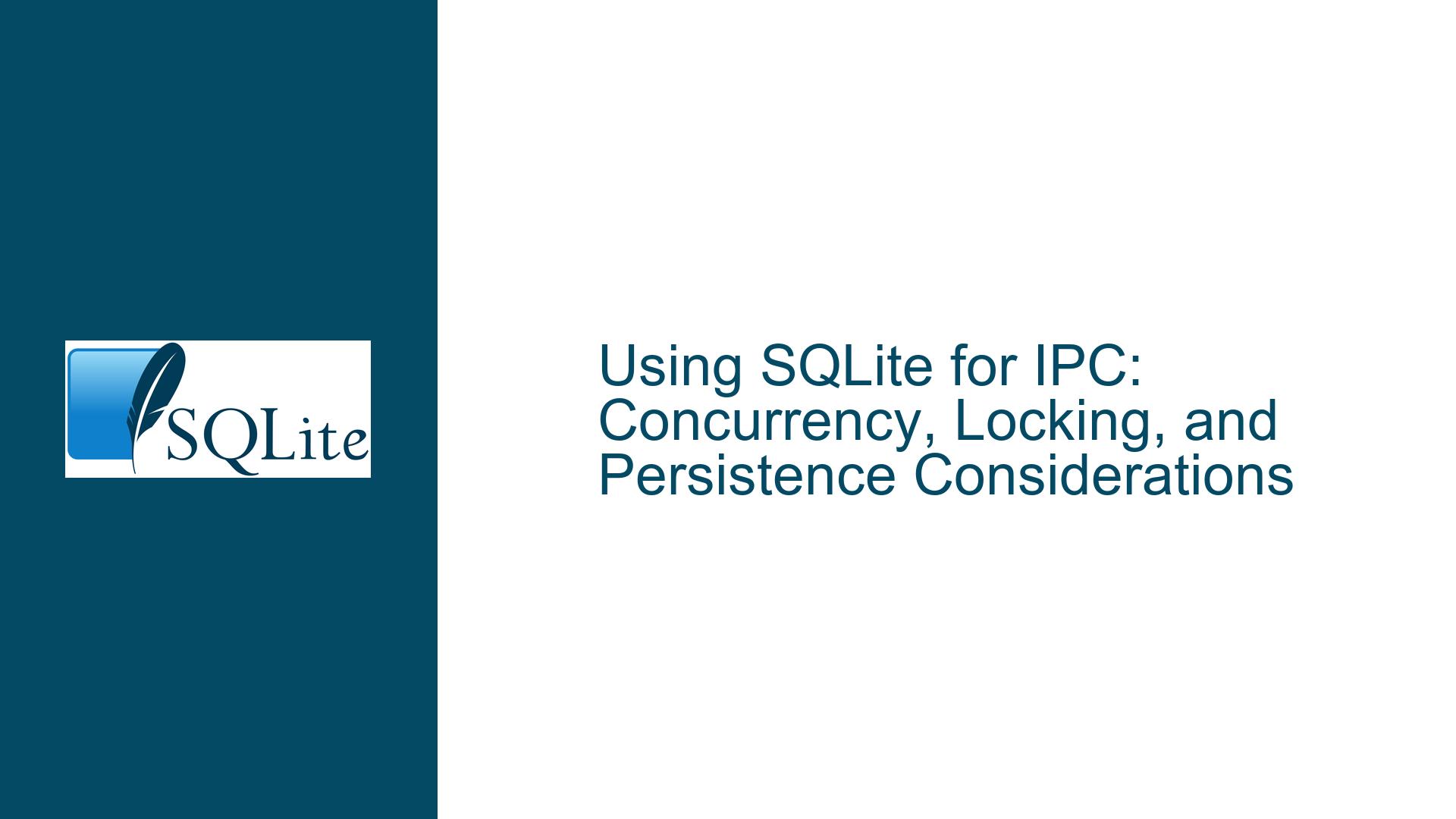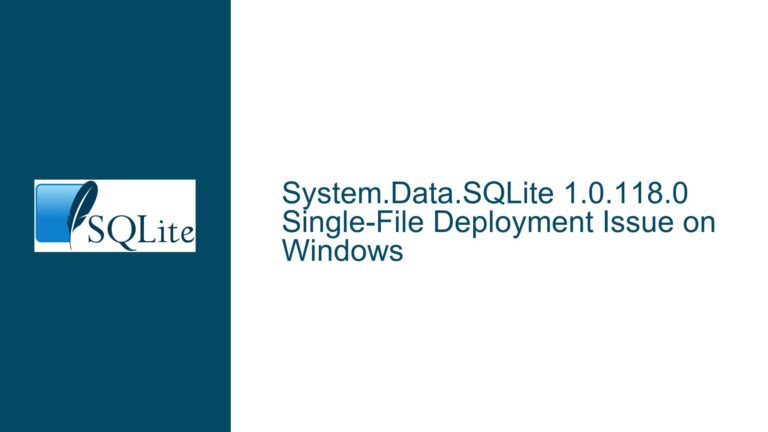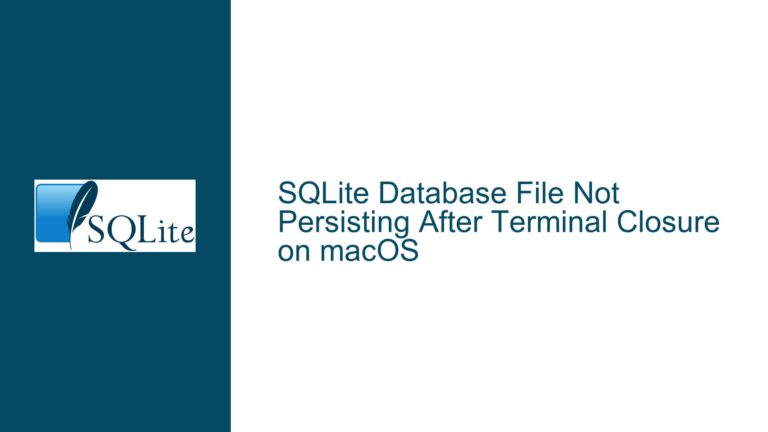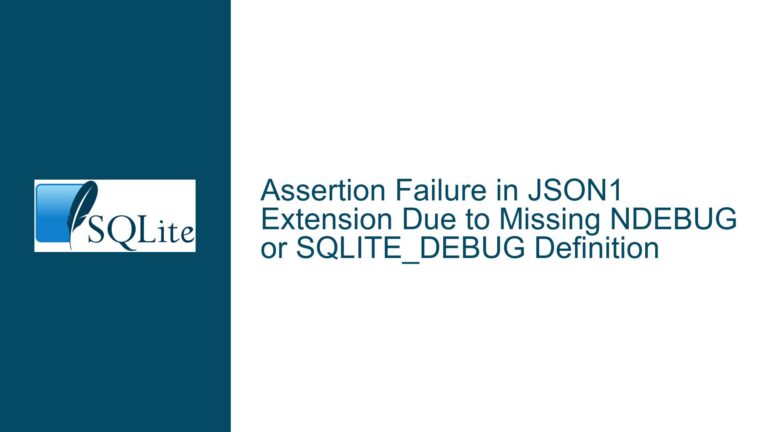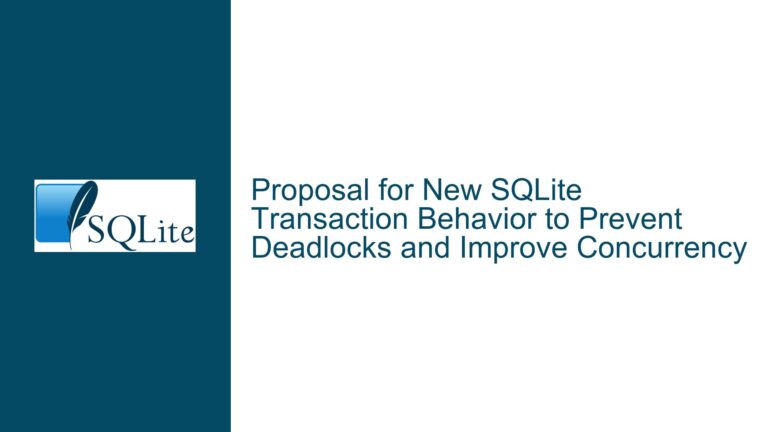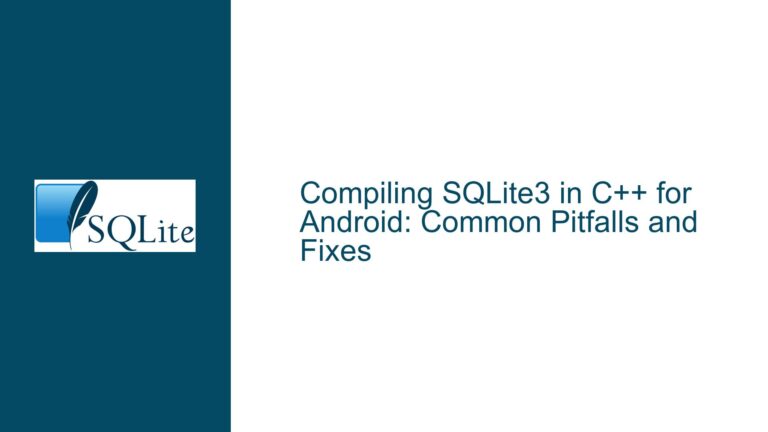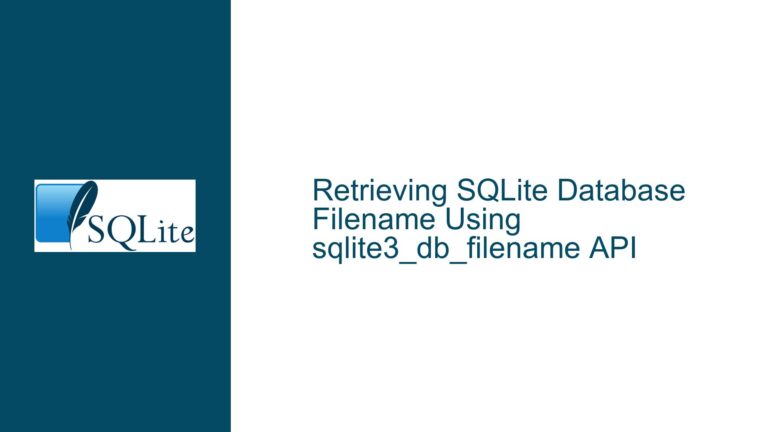Using SQLite for IPC: Concurrency, Locking, and Persistence Considerations
Challenges in Implementing SQLite as an IPC Mechanism
SQLite’s architecture as an embedded database engine makes it an unconventional but viable candidate for inter-process communication (IPC) when persistence, transactional guarantees, and schema constraints are required. The core challenge lies in reconciling SQLite’s locking model, transaction isolation semantics, and disk I/O behavior with real-time or near-real-time communication requirements between processes. Unlike traditional IPC mechanisms such as message queues, shared memory, or pipes, SQLite imposes a structured data management layer that introduces unique constraints around concurrency control, filesystem synchronization, and write amplification.
A typical IPC workflow using SQLite involves multiple processes accessing a shared database file, with writers inserting messages or state updates into tables and readers polling for changes. While SQLite handles concurrent reads efficiently in WAL (Write-Ahead Logging) mode, write contention escalates rapidly when multiple processes attempt simultaneous modifications. The database’s reliance on filesystem locks—particularly the distinction between SHARED, RESERVED, PENDING, and EXCLUSIVE locks—creates bottlenecks in high-throughput scenarios. For example, a writer process must escalate from a RESERVED lock to an EXCLUSIVE lock during commit, which requires waiting for all active readers to release their SHARED locks. This escalation path introduces latency spikes and potential deadlocks if transactions are not carefully managed.
The persistence aspect further complicates IPC use cases. While SQLite guarantees ACID compliance, the durability of transactions depends on proper synchronization to disk (e.g., PRAGMA synchronous=FULL), which introduces overhead. In contrast, traditional IPC mechanisms like SysV message queues or Unix domain sockets prioritize ephemeral data exchange without built-in persistence. Applications leveraging SQLite for IPC must therefore balance the need for crash recovery and auditability against the performance penalties of frequent disk writes.
Concurrency Conflicts and Locking Overheads in Multi-Writer Scenarios
The primary source of instability in SQLite-based IPC systems stems from improper handling of lock transitions during concurrent write operations. SQLite employs a strict locking hierarchy to enforce transaction isolation, but this hierarchy assumes cooperative behavior from all processes accessing the database. When multiple writers are present, lock contention becomes inevitable unless transactions are explicitly managed to minimize exclusive lock durations.
In rollback journal mode (the default transaction journaling mechanism), a writer must obtain a RESERVED lock before modifying the database, followed by a PENDING lock during commit. The PENDING lock blocks new readers from acquiring SHARED locks, while the EXCLUSIVE lock is required to finalize the write. This sequence creates a critical section where the database file is temporarily inconsistent, necessitating atomic updates via the rollback journal. If a reader attempts to access the database during this window—for example, by polling for new messages—it may encounter transient errors, partial reads, or corruption if the filesystem does not enforce strict locking semantics.
WAL mode alleviates some of these issues by allowing readers and writers to coexist without blocking each other, but it introduces its own limitations. WAL relies on shared memory (the wal-index) for coordinating readers and writers, which is incompatible with network filesystems or scenarios where processes are distributed across machines. Additionally, WAL’s checkpointing mechanism can introduce unpredictable latency if the WAL file grows excessively, forcing a merge with the main database file during reader checkpoints.
Another underappreciated cause of concurrency issues is transaction scope mismanagement. Long-running transactions—even read-only ones—hold SHARED locks, preventing writers from escalating to RESERVED or EXCLUSIVE locks. For IPC workflows where processes need to maintain open connections to the database (e.g., persistent message queues), idle transactions can inadvertently block writers, leading to cascading delays.
Filesystem behavior further exacerbates these challenges. Network filesystems like NFS often provide weak guarantees around file locking and cache coherency, making them unsuitable for multi-writer SQLite IPC setups. Even on local filesystems, aggressive caching by the operating system can mask locking conflicts, leading to non-deterministic behavior under load.
Optimizing SQLite for Reliable and Scalable IPC Workflows
To mitigate concurrency and locking challenges, applications using SQLite for IPC must adopt a combination of schema design optimizations, transaction management strategies, and operational safeguards.
Schema Design for Low Contention: Structure IPC message tables to minimize row-level contention. Use monotonic identifiers (e.g., INTEGER PRIMARY KEY AUTOINCREMENT) for message insertion to avoid index fragmentation. Partition messages into topic-specific tables or shard the database by process group to reduce write amplification. For example, a job queue can separate pending jobs, in-progress jobs, and completed jobs into distinct tables, allowing writers and readers to target non-overlapping regions of the database.
Explicit Transaction Control: Always use BEGIN IMMEDIATE or BEGIN EXCLUSIVE for write transactions to preemptively acquire RESERVED locks, reducing the likelihood of deadlocks. Keep transactions as short as possible—insert a single message per transaction if necessary—to limit the duration of RESERVED and EXCLUSIVE locks. For read-heavy workflows, leverage PRAGMA read_uncommitted=1 to enable dirty reads, bypassing SHARED lock acquisition at the cost of isolation guarantees.
Polling Strategies with Exponential Backoff: Instead of continuous polling, implement adaptive sleep intervals between read attempts. Use SQLite’s ON CONFLICT clauses to handle race conditions during message acknowledgment. For instance, a reader can mark a message as processed using an atomic UPDATE ... WHERE processed=0 query, avoiding the need for explicit locks.
WAL Mode with Local Filesystems: Where possible, enable WAL mode (PRAGMA journal_mode=WAL) to decouple readers from writers. Ensure that all processes accessing the database reside on the same physical machine to avoid WAL’s shared memory limitations. Monitor WAL file size and trigger manual checkpoints during idle periods using PRAGMA wal_checkpoint(TRUNCATE) to prevent uncontrolled growth.
Filesystem and OS Configuration: Disable filesystem caching for the database file using PRAGMA mmap_size=0 and PRAGMA locking_mode=EXCLUSIVE if processes can tolerate coarse-grained locking. On Unix-like systems, mount the database directory with noatime and sync options to reduce metadata overhead and enforce write barriers. Avoid network filesystems entirely; instead, use a local filesystem with a synchronization daemon for cross-machine IPC.
Fallback to Hybrid IPC Models: For latency-sensitive workflows, combine SQLite with traditional IPC mechanisms. Use shared memory or semaphores to signal the availability of new messages, reserving SQLite for persistent storage. For example, a writer can insert a message into the database and then post a notification via a Unix socket, allowing readers to poll SQLite only when updates are signaled.
Monitoring and Diagnostics: Instrument the application to track lock acquisition times, transaction durations, and retry counts. Use SQLite’s sqlite3_trace_v2 API to log contentious queries and identify long-held locks. Enable the SQLITE_CONFIG_LOG callback to capture internal SQLite errors and warnings, such as SQLITE_BUSY or SQLITE_LOCKED conditions, which indicate locking bottlenecks.
By adhering to these practices, SQLite can serve as a robust IPC mechanism for non-realtime workloads, offering the dual benefits of structured data management and crash resilience. However, designers must rigorously evaluate their concurrency requirements and test under realistic load to avoid pathological lock contention scenarios.
